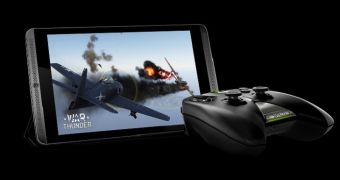NVIDIA has made a lot of headlines not so long ago when it launched with fanfare its Shield tablet, which aims to be the first consumer-friendly slate especially optimized for the act of gaming.
The tablet comes with some impressive specifications and NVIDIA claims that playing desktop games on the device will not be a problem anymore. The tab is also one of the first to come equipped with the Tegra K1 (clocked at 2.2GHz) SoC.
Anyway, the tablet has started shipping out to early adopters living in the US and Canada, but maybe you’re not entirely convinced whether the Shield slate is the one for you, and if that's the case, keep reading.
In an earlier piece we argued that the tablet might be downfall of gaming consoles and not only because of sheer performance.
Although, when playing an advanced title, you’ll want to make sure your tab is speedy and responsive. Forbes has been in the process of testing the device and has run a few benchmark tests on it. The results are quite disruptive.
For example, in the comprehensive MobileXPRT benchmark, the tablets scored 310, a result that placed it 21.5% higher than the Samsung Galaxy Tab S (which only got 255), a recent slate that also comes with an impressive spec list.
In the popular AnTuTu, the Shield tab overshadowed every other tablet involved in the race, with the exception of a few memory sections where Intel’s Bay Trail platform ruled supreme.
But where the Shield tablet seems to be at home is in graphics tests. In the GFX Bench 3.0 T-Rex off-screen benchmark, the Shield got 65.8 fps, a score that simply blew away the competition. The runner-up was the LG G Flex, which managed to score a meager 33.5 fps.
Similar results were seen in the 3DMark Ice Storm benchmark, where the Shield was placed against the Dell Venue 8 Pro tablet that got 15,508 points and the Samsung Galaxy Tab S, which snatched 13,376. However, the Shield tab scored a glorious 31,546 – which is almost double of what the two tablets got.
So, it appears that our hunches about the tablet were quite right and the slate is capable of delivering crushing performance. However, we should still wait until the device reaches a wider number of consumers in order to have a clear verdict. Hopefully, the tablet will be able to function in real life as well as it sounds on paper.

 14 DAY TRIAL //
14 DAY TRIAL //